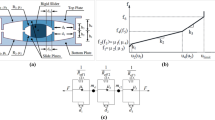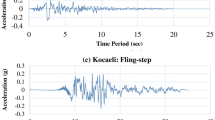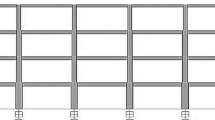Abstract
After a strong earthquake, archetypes of earthquake-resistant structural systems suffer damages that cause irreparable human, financial, social and economic effects. Friction pendulum base isolation technique is a system to reduce seismic vulnerability using subsystem isolation. The base isolation layouts are less studied. A proper layout of friction pendulum bearing system (FPS) in base-isolated asymmetric buildings has been derived and confirmed using 12 bi-directional ground motions to estimate mean maximum response values for various eccentricities. The FPS bearings were divided into two models: conventional, where all bearings have the same curvature radius, and non-conventional, where some bearings have a different curvature radius or stiffness. The center of the radius of curvature for the non-conventional models was aligned with six different points, including the roof's geometric center, the center of cumulative mass in the base, and the center of rigidity in the first story. Additionally, the center of stiffness of FPS bearings coincided with the centers of the cumulative mass at base level and the rigidity of the superstructure in the first story. The results of the non-linear time history analysis show that, for a low superstructure eccentricity of %5, responses did not differ significantly among the nine configurations tested. At higher eccentricities, there was a significant difference between the responses of the different models. It is recommended that the stiffness center of all FPS coincide with the superstructure’s cumulative mass center for proper responses. This layout can be effective in improving the seismic performance of FPS-base-isolated asymmetric buildings.
Graphical Abstract



















Similar content being viewed by others
Data availability
No datasets were generated or analyzed during the current study.
References
ACI318–19, Building code requirements for structural concrete, American concrete institute
Adibramezani AM, Ziyaeifar M (2009) Assessment of a technique for the torsional response reduction of seismic isolated asymmetric structures. J Appl Sci 9:2653–2670. https://doi.org/10.3923/jas.2009.2653.2670
ASCE/SEI (American society of civil engineers), ASCE/SEI 7–22 (2022) Minimum design loads and associated criteria for buildings and other structures. https://ascelibrary.org/doi/book/https://doi.org/10.1061/9780784415788
Castaldo P, Amendola G (2021) Optimal sliding friction coefficients for isolated viaducts and bridges: a comparison study. J Struct Control Health Monitor. https://doi.org/10.1002/stc.2838
Castaldo P, Palazzo B, Della VP (2015) Seismic reliability of base-isolated structures with friction pendulum bearings. Eng Struct 15(95):80–93. https://doi.org/10.1016/j.engstruct.2015.03.053
Castaldo P, Palazzo B, Ferrentino T, Petrone G (2016) Influence of the strength reduction factor on the seismic reliability of structures with FPS considering intermediate PGA/PGV ratios. J Compos B. https://doi.org/10.1016/j.compositesb.2016.09.072
Chen H, Haichao X, Liu Y, Ren X (2023) Seismic demand estimation of isolated buildings with nonlinear bearings subjected to linear response spectra. J Build Eng 67:105995. https://doi.org/10.1016/j.jobe.2023.105995
Dao ND, Nguyen-Van H, Nguyen TH, Chung AB (2020) A new statistical equation for predicting nonlinear time history displacement of seismic isolation systems. J Struct 24:177–190. https://doi.org/10.1016/j.istruc.2020.01.019
Deringöl AH (2018) Seismic performance of steel moment frames with variable friction pendulum systems under real ground motions. Int Adv Res Eng J 2(3):208–216
Deringöl AH, Güneyisi EM (2019) Effect of friction pendulum bearing properties on Behavior of buildings subjected to seismic loads. Soil Dyn Earthq Eng. https://doi.org/10.1016/j.soildyn.2019.105746
Eisenberger M, Rutenberg A (1996) Seismic base isolation of asymmetric shear buildings. J Eng Struct 8:2–8
Etedali S, Sohrabi M (2011) Torsional strengthening of base-isolated asymmetric structures by increasing the flexible edge stiffness of isolation system. Int J Civ Environ Eng 11:51–59
Fallahian M, Khoshnoudian F, Loghman V (2015) Torsionally seismic behavior of triple concave friction pendulum bearing. Adv Struct Eng 18:2151–2166. https://doi.org/10.1260/1369-4332.18.12.2151
FEMA (Building seismic safety council for the federal emergency management agency of the department of homeland security), 2006, FEMA451–11, National Institute of Building Sciences Washington, DC https://www.wbdg.org/FFC/DHS/ fema451.pdf
FEMA-356 (2000) Federal emergency management agency. Prestandard and commentary for the seismic rehabilitation of buildings. https://www.nehrp.gov/pdf/fema356.pdf
Hsseini S (2022) Seismic performance of asymmetric isolated steel structures with different bracing systems. Amirkabir J Civ Eng 53(12):5569–5588
Jalali Y, Amiri GG, Shakouri A (2021) Comparative response assessment of base-isolated braced-frame buildings considering effects of ductility design. J Build Eng 43:103110. https://doi.org/10.1016/j.jobe.2021.103110
Jangid R (2005) Optimum friction pendulum system for near-fault motions. J Eng Struct 27:349–359. https://doi.org/10.1680/stbu.2007.160.4.207
Jangid R, Datta T (1994) Nonlinear response of the torsionally coupled base-isolated structure. J Struct Eng 120:1–22. https://doi.org/10.1260/1369433021502605
Khoshnoudian F, Azad AI (2011) Effect of two horizontal components of the earthquake on the nonlinear response of torsionally coupled base-isolated structures. J the Struct Des Tall Spec Build 20:986–1018. https://doi.org/10.1002/tal.571
Kitayama S, Constantinou MC (2019) Probabilistic seismic performance assessment of seismically isolated buildings designed by the procedures of ASCE/SEI 7 and other enhanced criteria. Eng Struct 179:566–582. https://doi.org/10.1016/j.engstruct.2018.11.014
Landi L, Grazi G, Diotallevi PP (2016) Comparison of different models for friction pendulum isolators in structures subjected to horizontal and vertical ground motions. J Soil Dyn Earthq Eng 81:75–83. https://doi.org/10.1016/j.soildyn.2015.10.016
Lee DM (1980) Base isolation for torsion reduction in asymmetric structures under earthquake loading. J Earthq Eng Struct Dyn 8:349–359. https://doi.org/10.1002/eqe.4290080405
Li Z, Chen X, Huang G, Kareem A, Zhou X (2023) Alongwind and crosswind response of friction-pendulum base-isolated high-rise buildings. Eng Struct 15:116564. https://doi.org/10.1016/j.engstruct.2023.116564
Nagarajaiah S, Reinhorn AM, Constantinou MC (1993) Torsion in base-isolated structures with elastomeric isolation systems. J Struct Eng 119:2932–2951. https://doi.org/10.1061/(ASCE)0733-9445(1993)119:10(2932)
NEHRP B. S. S. (2006) Council, recommended provisions for seismic regulations for new buildings and other structures, NEHRP2000–13, Federal emergency management agency, Washington, DC 05–05. https://www.nehrp.gov/pdf/ fema450provisions.pdf
Ocak A, Nigdeli SM, Bekdaş G (2023) Optimization of the base isolator systems by considering the soil-structure interaction via metaheuristic algorithms. Structures 56:104886. https://doi.org/10.1016/j.istruc.2023.104886
Olivares CI, Juan C, Poulos A (2020) Torsion control in structures isolated with the triple friction pendulum system. J Eng Struct 216:110503. https://doi.org/10.1016/j.engstruct.2020.110503
Petti L, Polichetti F, Lodato A, Palazzo B (2013) Modeling and analysis of base isolated structures with friction pendulum system considering near fault events. J Open J Civ Eng 3:86–93. https://doi.org/10.4236/ojce.2013.32009
Rahgozar A, Estekanchi HE, Ali Mirfarhadi S (2023) On optimal triple friction pendulum base-isolation design for steel moment-frame buildings employing value-based seismic design methodology. J Build Eng. https://doi.org/10.1016/j.jobe.2022.105494
Rincy M, Saju ES (2016) Comparative study of RC framed building with isolator and dampers. Int J Eng Res Technol (IJERT) 4:13. https://doi.org/10.17577/IJERTCONV4IS13012
Saritaş F, Bedirhanoglu I, Konak A, Keskin MS (2022) Effect of seismic isolation on the performance of high-rise buildings with torsional instability. Sustainability 15(1):36
Shyamsunder L, Pandey DK, Mishra SK (2021) Behavior of torsionally coupled buildings isolated by super-elastic bearing subjected to earthquakes. J Build Eng 43:102573. https://doi.org/10.1016/j.jobe.2021.102573
Soni D, Mistry B, Panchal V (2010) Behavior of asymmetric building with double variable frequency pendulum isolator. J Struct Eng Mech 11:61. https://doi.org/10.12989/sem.2010.34.1.061
Sreenivas D, Mathew A (2016) Seismic performance of base isolated buildings with plan irregularity. Int J Sci Technol Eng 3:02
Tajammolian H, Khoshnoudian F, Loghman V (2017) Rotational components of near-fault earthquakes effects on triple concave friction pendulum base-isolated asymmetric structures. J Eng Struct 142:110–127
Tena-Colunga A, Escamilla-Cruz JL (2007) Torsional amplifications in asymmetric base-isolated structures. J Eng Struct 29:237–247. https://doi.org/10.1016/j.engstruct.2006.03.036
Tsiavos A, Kolyfetis D, Panzarasa G, Burgert I, Stojadinovic B (2022) Shaking table investigation of a low-cost and sustainable timber-based energy dissipation system with recentering ability. Bull Earthq Eng 2022:1–20. https://doi.org/10.1007/s10518-022-01464-2
Zayas VA, Low SS, Mahin SA (1990) A simple pendulum technique for achieving seismic isolation. J Earthq Spectra 6:317–333. https://doi.org/10.1193/1.1585573
Zayas VA, Low SA, Bozzo L, and Mahin SA (1989) Feasibility and performance studies on improving the earthquake resistance of new and existing buildings using the friction pendulum system. J Earthq Eng Res Center. https://nehrpsearch.nist .gov/static/ files/NSF/PB92143064.pdf.
Zha Z, Zhanga R, Ji Y, Pan C (2019) Seismic response mitigation of structures with a friction pendulum inerter sysangtem. J Eng Struct 193:110–120. https://doi.org/10.3390/app10010257
Author information
Authors and Affiliations
Contributions
Mehdi Amri and Abdolreza S. Moghadam wrote the main manuscript text and Armin Aziminejad and Mohammadreza Mansoori.
Corresponding author
Ethics declarations
Conflict of interest
The authors declare no competing interests.
Rights and permissions
Springer Nature or its licensor (e.g. a society or other partner) holds exclusive rights to this article under a publishing agreement with the author(s) or other rightsholder(s); author self-archiving of the accepted manuscript version of this article is solely governed by the terms of such publishing agreement and applicable law.
About this article
Cite this article
Amri, M., Moghadam, A.S., Aziminejad, A. et al. The Effect of Varied Eccentricities of the Friction Pendulum Bearings on the Nonlinear Response of the Base-Isolated Asymmetric Buildings. Iran J Sci Technol Trans Civ Eng (2024). https://doi.org/10.1007/s40996-024-01375-z
Received:
Accepted:
Published:
DOI: https://doi.org/10.1007/s40996-024-01375-z




